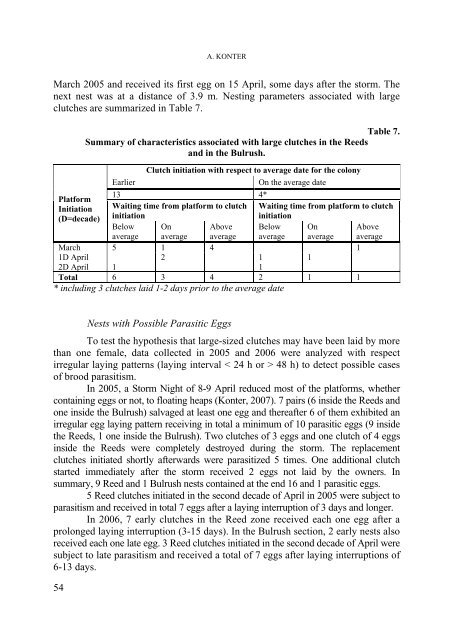biologia - Studia
biologia - Studia
biologia - Studia
Create successful ePaper yourself
Turn your PDF publications into a flip-book with our unique Google optimized e-Paper software.
A. KONTER<br />
March 2005 and received its first egg on 15 April, some days after the storm. The<br />
next nest was at a distance of 3.9 m. Nesting parameters associated with large<br />
clutches are summarized in Table 7.<br />
Table 7.<br />
Summary of characteristics associated with large clutches in the Reeds<br />
and in the Bulrush.<br />
Clutch initiation with respect to average date for the colony<br />
Earlier<br />
On the average date<br />
13 4*<br />
Platform<br />
Initiation Waiting time from platform to clutch Waiting time from platform to clutch<br />
(D=decade) initiation<br />
initiation<br />
Below On Above Below On Above<br />
average average average average average average<br />
March 5 1 4 1<br />
1D April 2 1 1<br />
2D April 1 1<br />
Total 6 3 4 2 1 1<br />
* including 3 clutches laid 1-2 days prior to the average date<br />
54<br />
Nests with Possible Parasitic Eggs<br />
To test the hypothesis that large-sized clutches may have been laid by more<br />
than one female, data collected in 2005 and 2006 were analyzed with respect<br />
irregular laying patterns (laying interval < 24 h or > 48 h) to detect possible cases<br />
of brood parasitism.<br />
In 2005, a Storm Night of 8-9 April reduced most of the platforms, whether<br />
containing eggs or not, to floating heaps (Konter, 2007). 7 pairs (6 inside the Reeds and<br />
one inside the Bulrush) salvaged at least one egg and thereafter 6 of them exhibited an<br />
irregular egg laying pattern receiving in total a minimum of 10 parasitic eggs (9 inside<br />
the Reeds, 1 one inside the Bulrush). Two clutches of 3 eggs and one clutch of 4 eggs<br />
inside the Reeds were completely destroyed during the storm. The replacement<br />
clutches initiated shortly afterwards were parasitized 5 times. One additional clutch<br />
started immediately after the storm received 2 eggs not laid by the owners. In<br />
summary, 9 Reed and 1 Bulrush nests contained at the end 16 and 1 parasitic eggs.<br />
5 Reed clutches initiated in the second decade of April in 2005 were subject to<br />
parasitism and received in total 7 eggs after a laying interruption of 3 days and longer.<br />
In 2006, 7 early clutches in the Reed zone received each one egg after a<br />
prolonged laying interruption (3-15 days). In the Bulrush section, 2 early nests also<br />
received each one late egg. 3 Reed clutches initiated in the second decade of April were<br />
subject to late parasitism and received a total of 7 eggs after laying interruptions of<br />
6-13 days.
















